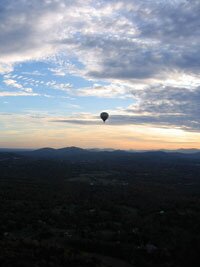Petal pusher: Burns' bouquets aren't like the rest

PHOTO BY JEN FARIELLO
Utter the term "wedding flowers" and some brides will break out into hives, unable to differentiate between daffodils and orchids, while others will confidently reel off the six different types of blooms they have in their bouquet alone. But no matter which category you fall in, the task of choosing blossoms for your nuptials shouldn't be a daunting task. And while some couples choose to go the traditional route, choosing a large florist to arrange their wedding day buds, Wendy Burns of Woodmont Designs advises brides looking for a more intimate and innovative floral ambiance to push aside their floristry fears and become best buds with local florists.
Burns, who works out of her home (and apple orchard) across from King Family Vineyards, has practiced the more labor intensive European style of floristry for years ever since she began helping a close friend in her floral shop in Pennsylvania. Moving down to Charlottesville 11 years ago, Burns finally opened her own European-minded floral design studio in the early 2000s, with a speciality in intricate bouquets and unexpected floral pairings. From weekly arrangements at Prince Michel and Farmington to corporate events, charity fundraisers, and nuptials at venues across the region, Burns and Woodmont Designs have tapped into the local floral consciousness. For even the most bloom-bewildered bride, Burns rounds up the latest floral trends.
Green greens
Wait– aren't flowers inherently green because they kind of come from the environment? While all plant life is essentially green in nature, they aren't always the most earth-friendly, notes Burns. When brides order blooms from a large, faceless company, what they don't realize is that those brightly tinged blooms aren't usually available locally and must be shipped in from regions around the globe– often leaving quite a hefty carbon footprint. By using an environmentally conscious florist, Burns says, brides can find gorgeous greenery without having to settle for the few blooms that may be in season at the time of their ceremony.
"When flowers come from a place like Ecuador, where they're grown in such a way that they've devastated the soil and been forced to grow unusually big– that's not being very green," Burns says. "I'm trying to be very aware of where my flowers are coming from. As much as possible, I grow my own."
While Burns tries to utilize as much of her nearly 30 acre estate as possible to grow various floral species, she notes the practice of discarding barely-faded blooms the day after a ceremony still negatively impacts the floral industry. Most green florists and brides are trying to give another life to day-old wedding flowers and Burns advises brides to try and donate their centerpieces to nursing homes, hospitals, or encourage guests to take home any pieces that will otherwise be discarded.
Going au-natural
Another seeming oxymoron in the floral industry is the concept of going natural– aren't all flowers natural, brides ask? Instead of just looking for pretty flowers, the floral industry has returned back to the natural elements of wooded areas for inspiration: bark, felled trees, vines, leaves, berries are all showing up in whimsical and elegant centerpiece designs, according to Burns. In her own studio, Burns amasses various species of moss, piles of bark, and vines from King Family to inform her own designs– and has even been known to pocket interesting finds she stumbles upon during her frequent hikes in the Blue Ridge Mountains.
"I'm having a great deal of fun bringing natural materials in from the woods and finding ways to use them," she says.
From using tree trunks as centerpiece stands to covering containers with bark, Burns has begun to create custom designs for the bride looking for a return to more local elements. With the trend of vineyard-inspired weddings, brides are looking to bring in woodsy, rustic charm to their nuptials.
"You have two extremes– one bride just wants all white roses, while others just want a few wildflowers for 150 guests and eight bridesmaids," says Burns. "But to create a look like that is not just going to the side of the road to pick some wildflowers."
Local versus large
While going to a large floral vendor is not at all a bad thing– it's all about personal style and taste– Burns notes that her floral sensibilities lean towards the more labor-intesive, yet intricate European style of arranging. "Hand-tied," an industry buzzword, accurately describes the work she does– placing each bloom individually in a bouquet, then twisting the stems to create more of a fan-shaped bunch. It's a style, she says, that stems from the flowers sold in European street markets fresh from a florist's own garden.
"It's a more personalized style and highly labor intensive," she says. "But it's one of the things that gave me the confidence to start my own business."
Due to the intricacy of her designs, Burns only takes on a few weddings a year, spending months on planning and creating. She advises brides to find their florist as soon as they've settled on a venue. Her linear designs and whimsical aesthetics– one of her signature pieces is a centerpiece with small votives hanging off twisty branches– are elements that make her appeal to the bride looking for an intimate and often unrepeatable floral design.
"Everything I do is a custom design," she says. "Big shops can't do what I do."
#